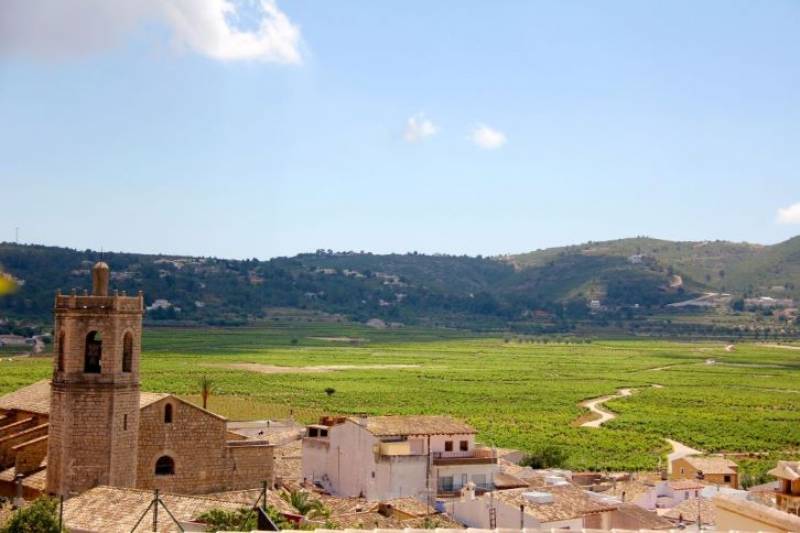article_detail
Landmark win for Alicante expats as hundreds of homes legalised after decades-long battle
ARCHIVED ARTICLE -
It’s a potential watershed moment for hundreds of expats in the village of Llíber, Alicante and hundreds of thousands across the Valencia region

by John Michael Kirby, Technical Architect and Building Engineer
Terms such as “watershed, milestone, turning point, tipping point” are typically used in a loose hyperbolic fashion and, while it is possible that what happened in Llíber Town Hall on April 30, 2024 may turn out to be another one of those events, there are solid reasons to believe that this time it might just turn out to be true.
To comprehend the scale of the collective sigh of relief in that municipality and hundreds of others which are hoping to follow the model they are creating, we need to get into the detail but, the big-picture context is that if what just happened in Llíber were to be repeated across all 542 municipalities just in the Valencia region, some 30,000 previously illegal properties would be well on their way to full legalisation.
There are some 200,000 illegal rural properties just in the Valencia region alone. In some areas, particularly in the province of Alicante, the majority of those properties are currently in the hands of expats. The reason, in the vast majority of cases, is simply that expats didn’t know what they were buying at the time they bought those properties. In most cases they weren’t duped; they simply were not told the full facts. They knew they were defenseless in this process and they also knew the penalty for any mistakes was the potential loss of their life savings so they hired a lawyer to shield them.
Here’s the problem that has led to so much unnecessary suffering: those lawyers had a clear conflict of interests and were not in favour of the expat clients. As the income stream for the lawyers depended almost entirely on the stream of recommendations from the estate agencies the role of the lawyers was to “make the sale happen” their role became facilitator instead of adviser. It’s not that they had to tell lies – they didn’t – they lied by omission, not telling the whole story.
An illegal property cannot request a building licence for repairs or improvements, so it’s useful life cannot be extended. As such, these properties, as defined by law, only face two potential destinies – either voluntary demolition or natural wrack and ruin. How many of the hundreds of thousands of expats that invested their life savings in these properties do you think were told that? I’m betting close to zero.

Yes, the owner of an illegal property cannot be prosecuted for an infraction after the statute of limitations, the property cannot be ordered to be demolished and it can be incorporated into the judicial flow. However, it continues to be 100% illegal unless the property was built before the amnesty law of 1975. In fact the law (TRLOTUP) in Valencia specifically states that a property is NOT legalised by the mere passage of time.
Until 2014, that statute of limitations, the period of time after which you cannot be prosecuted, was four years. In 2014 under the LOTUP it was extended to 15 and in 2019 the statute of limitations was eliminated. That means the time given to the authorities for illegal rural builds after 2019 is now infinite, it’s no longer a race against the clock to see if you can go undetected for x number of years.
The importance of reaching that statute of limitations finishing line is that you can only register in the land registry a property, if unlicensed, is beyond the statute of limitations. If you can do that, your property can be included in the judicial flow “El flujo jurídico”, which means you can create a deed for it. Once that’s done, the property, especially from a non-Spanish-speaking expat’s perspective, has all the outward appearance of a fully legal property. Your lawyer says “go ahead”, it has a deed with no encumbrances, it’s registered at the land registry to the guy that’s selling it to you. As we have seen, this is just a smokescreen for the very severe restrictions these properties face.
What happened in the village of Llíber and in others such as Catral is worse. Much worse. Between the years 1999 and 2005 in the village of Lliber 298 municipal licences were given to build houses. An expansion which represented a doubling of the population of the village in just 5 years. All these houses were sold to expats. The problem being none of these licences were valid and therefore all of those houses were, and are still to this day, 100% illegal.
In 2004, a really small and obscure subsection of a fairly obscure law opened the opportunity to the legalisation of these properties. Disposición transitoria cuarta de ley 10/2004, 4th transitory clause of law 10/2004, couldn’t really sound less important if it tried, right? However, it introduced the concept of MIT, legalisation through Territorial Impact Minimisation licences. It wasn’t available for individual cases and it was clearly defined for collective cases either. Proof of the latter is that there still hasn’t been a single successful case of collective legalisation through MIT to date. However, it did introduce the idea.
 In 2019, the big breakthrough came. Vicente Garcia Nebot, the then regional Director General of town planning for the Valencia region, didn’t just modify the law he introduced an MIT ecosystem which is truly revolutionary. Adrian Hobbs (pictured, left), the President of the AUN and the HOA for affected owners of the “Caso Ruinas” of Llíber once called it, “The best news we’ve had for nearly 30 years”.
In 2019, the big breakthrough came. Vicente Garcia Nebot, the then regional Director General of town planning for the Valencia region, didn’t just modify the law he introduced an MIT ecosystem which is truly revolutionary. Adrian Hobbs (pictured, left), the President of the AUN and the HOA for affected owners of the “Caso Ruinas” of Llíber once called it, “The best news we’ve had for nearly 30 years”.The Ecosystem consists of a detailed individual (DSI) and collective route to legalisation, the creation of an agency to stop illegal building in the countryside (AVPT), the elimination of the statute of limitations for this type of crime so the cycle of illegal build followed by subsequent incorporation into the judicial flow was finally broken, the creation of GuiaT the electronic platform which makes sectorial impact reports something anyone can do, cost free, in a matter of minutes, the creation of the ECUVs which allows the affected owners to circumvent the already saturated municipal technical services by using external agencies licensed as competent for approving the technical reports required for politicians to approve the legalisations.
A whole host of other stars had to align in order for progress to be made in Llíber. They had to form and maintain a group of affected owners, which they did by forming their local branch of the AUN. That association had to be run for two decades by a guy, Adrian Hobbs, who doesn’t know how to quit even in the face of almost insurmountable odds. Before that could happen the template for forming that association had to be imagined, financed, brought into reality and then propagated. Charles Svoboda did that. A name that to this day still strikes if not fear certainly pangs of significant anxiety in many within the public administration.
The result has been that 26 of the approximately 250 cases for potential legalisation through MIT DSI (the individual route) have now attained first stage approval. More importantly the template for doing so has now been established and the remaining 90% of cases can now easily follow suit.
Second, and final, stage approval is now being sought. In the case of the properties in Llíber, it should be remembered that these properties received municipal building licences. I used to be a municipal technician here in Valencia. For a licence to be issued the council, more specifically the municipal technician, has to have seen the architectural project and approved it as compliant with both technical regulations and town planning. The licences turned out to be invalid, in a corruption case known as “Caso Ruinas”, despite a few arrests no-one has yet been convicted in the more than twenty years since the events. The licences were not declared invalid because of the technical reports so, in theory at least, these properties already have plans which have been approved by the council.

Between AUN in Llíber and the town council, we hope to establish a template for technical approval which will incorporate a graphical description of the properties and their location, a certificate of MIT compliance by a competent technician, in exactly the same way we approve occupation licences with respect to the laws governing habitability (HD 91, DC 09 and decreto 80/ 2023). In addition, in the case that additional works are required for MIT compliance, the corresponding technical project for those works.
Legalisation means a significant increase in the value of the property concerned, it’s the best investment available to homeowners. That entails reinvestment and economic stimulus. Legalisation means social integration instead of ghettos and a feeling of finally belonging to that town or village. Mostly, it means redemption and peace of mind for the owners and the future of their families.
If you are interested in getting your rural property legalised these are the steps to follow:
Step 1: Get organised as a group
Step 2: Get informed. See links below
Step 3: Have frank and open meetings, online works perfectly well. Invite me to attend virtually and I’ll do so.
Step 4: Have a plan, a specific proposal to give to your council, “We are x many houses in such and such area and we would like you to follow “the Llíber model”. If they don’t know what that is they, like you, can get in touch with me through Alicante Today.
Useful links to learn more about illegal homes in Spain and where to get help
- Proving your house is legalisable through the MIT licence
- MIT Application form GV60301
- Catastro webpage
- Guia-T webpage (remember you need a digital signature to use this page)
- How to use Guia-T to make the sectorial impact report free of charge and in less than 5 minutes step by step
- A guide to occupation licences
- The MIT Orientation guide (English version)
- ICV tool for proving the date of construction of your property
- How to find your house on the catastro database
John Kirby is a Technical Architect and Building Engineer (UPV), having won the award for outstanding academic achievement. He is the first foreigner to win that award and the only foreigner to ever be Municipal Technical Architect in Spain and a Judicial Property expert witness in Spain. He is Commisioner for Expatriates of the Valencian government and Ambassador for Spain and Gibraltar for Chartered Association of Building Engineers (UK).
Loading
Sign up for the Spanish News Today Editors Roundup Weekly Bulletin and get an email with all the week’s news straight to your inbox
Special offer: Subscribe now for 25% off (36.95 euros for 48 Bulletins)
OR
you can sign up to our FREE weekly roundup!
Read some of our recent bulletins:
Discount Special Offer subscription:
36.95€ for 48 Editor’s Weekly News Roundup bulletins!
Please CLICK THE BUTTON to subscribe.
(List price 3 months 12 Bulletins)
Read more stories from around Spain:
Contact Spanish News Today: Editorial 966 260 896 /
Office 968 018 268


























